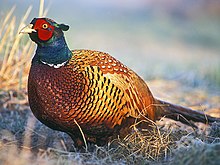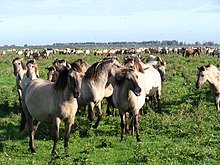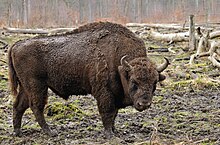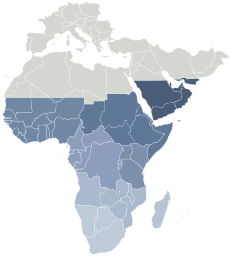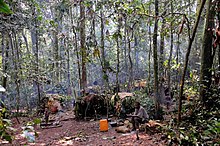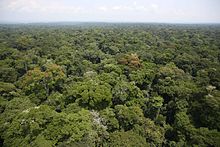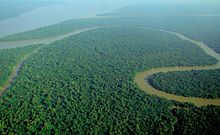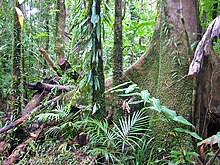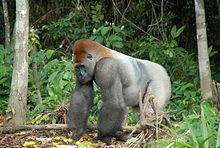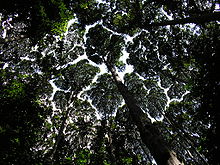Wildlife management attempts to balance the needs of wildlife with the needs of people using the best available science. Wildlife management can include game keeping, wildlife conservation and pest control. Wildlife management draws on disciplines such as mathematics, chemistry, biology, ecology, climatology and geography to gain the best results.
Wildlife conservation aims to halt the loss in the Earth's biodiversity by taking into consideration ecological principles such as carrying capacity, disturbance and succession and environmental conditions such as physical geography, pedology and hydrology. Most wildlife biologists are concerned with the preservation and improvement of habitats although rewilding is increasingly being used. Techniques can include reforestation, pest control, nitrification and denitrification, irrigation, coppicing and hedge laying.
Game keeping is the management or control of wildlife for the well-being of game and may include the killing of other animals which share the same niche or predators to maintain a high population of more profitable species, such as pheasants introduced into woodland. In his 1933 book Game Management, Aldo Leopold, one of the pioneers of wildlife management as a science, defined it as "the art of making land produce sustained annual crops of wild game for recreational use".
Pest control is the control of real or perceived pests and can be used for the benefit of wildlife, farmers, game keepers or human safety. In the United States, wildlife management practices are often implemented by a governmental agency to uphold a law, such as the Endangered Species Act.
In the United Kingdom, wildlife management is undertaken by several organizations including government bodies such as the Forestry Commission, Charities such as the RSPB and The Wildlife Trusts and privately hired gamekeepers and contractors. Legislation has also been passed to protect wildlife such as the Wildlife and Countryside Act 1981. The UK government also give farmers subsidies through the Countryside Stewardship Scheme to improve the conservation value of their farms.
Wildlife conservation aims to halt the loss in the Earth's biodiversity by taking into consideration ecological principles such as carrying capacity, disturbance and succession and environmental conditions such as physical geography, pedology and hydrology. Most wildlife biologists are concerned with the preservation and improvement of habitats although rewilding is increasingly being used. Techniques can include reforestation, pest control, nitrification and denitrification, irrigation, coppicing and hedge laying.
Game keeping is the management or control of wildlife for the well-being of game and may include the killing of other animals which share the same niche or predators to maintain a high population of more profitable species, such as pheasants introduced into woodland. In his 1933 book Game Management, Aldo Leopold, one of the pioneers of wildlife management as a science, defined it as "the art of making land produce sustained annual crops of wild game for recreational use".
Pest control is the control of real or perceived pests and can be used for the benefit of wildlife, farmers, game keepers or human safety. In the United States, wildlife management practices are often implemented by a governmental agency to uphold a law, such as the Endangered Species Act.
In the United Kingdom, wildlife management is undertaken by several organizations including government bodies such as the Forestry Commission, Charities such as the RSPB and The Wildlife Trusts and privately hired gamekeepers and contractors. Legislation has also been passed to protect wildlife such as the Wildlife and Countryside Act 1981. The UK government also give farmers subsidies through the Countryside Stewardship Scheme to improve the conservation value of their farms.
History
Game laws
The history of wildlife management begins with the game laws, which regulated the right to kill certain kinds of fish and wild animal (game). In Britain game laws developed out of the forest laws, which in the time of the Norman kings were very oppressive. Under William the Conqueror,
it was as great a crime to kill one of the king's deer as to kill one
of his subjects. A certain rank and standing, or the possession of a
certain amount of property, were for a long time qualifications
indispensably necessary to confer upon any one the right of pursuing and
killing game.
The Game Act of 1831 protected game birds
by establishing close seasons when they could not be legally taken. The
act made it lawful to take game only with the provision of a game
licence and provided for the appointment of gamekeepers around the country. The purposes of the law was to balance the needs for preservation and harvest and to manage both environment and populations of fish and game.
The Game Act 1831 protects game birds in England and Wales
Early game laws were also enacted in the US; in 1839 Rhode Island closed the hunting season for white-tailed deer from May to November.
Other regulations during this time focused primarily on restricting
hunting. At this time, lawmakers did not consider population sizes or
the need for preservation or restoration of wildlife habitats.
Emergence of wildlife conservation
The late 19th century saw the passage of the first pieces of wildlife
conservation legislation and the establishment of the first nature
conservation societies. The Sea Birds Preservation Act of 1869 was passed in Britain as the first nature protection law in the world after extensive lobbying from the Association for the Protection of Seabirds.
The Royal Society for the Protection of Birds was founded as the Plumage League in 1889 by Emily Williamson at her house in Manchester as a protest group campaigning against the use of great crested grebe and kittiwake skins and feathers in fur clothing. The group gained popularity and eventually amalgamated with the Fur and Feather League in Croydon to form the RSPB.
The Society attracted growing support from the suburban middle-classes
as well as support from many other influential figures, such as the ornithologist Professor Alfred Newton.
The National Trust
formed in 1895 with the manifesto to "...promote the permanent
preservation, for the benefit of the nation, of lands, ...to preserve
(so far practicable) their natural aspect." On 1 May 1899, the Trust
purchased two acres of Wicken Fen with a donation from the amateur naturalist Charles Rothschild, establishing the first nature reserve in Britain.
Rothschild was a pioneer of wildlife conservation in Britain, and went
on to establish many other nature reserves, such as one at Woodwalton Fen, near Huntingdon, in 1910. During his lifetime he built and managed his estate at Ashton Wold in Northamptonshire
to maximise its suitability for wildlife, especially butterflies.
Concerned about the loss of wildlife habitats, in 1912 he set up the
Society for the Promotion of Nature Reserves, the forerunner of The Wildlife Trusts partnership.
During the society's early years, membership tended to be made up of specialist naturalists
and its growth was comparatively slow. The first independent Trust was
formed in Norfolk in 1926 as the Norfolk Naturalists Trust, followed in
1938 by the Pembrokeshire Bird Protection Society which after several
subsequent changes of name is now the Wildlife Trust of South and West
Wales and it was not until the 1940s and 1950s that more Naturalists'
Trusts were formed in Yorkshire, Lincolnshire, Leicestershire and Cambridgeshire. These early Trusts tended to focus on purchasing land to establish nature reserves in the geographical areas they served.
Wildlife management in the US
The profession of wildlife management was established in the United States in the 1920s and 1930s by Aldo Leopold
and others who sought to transcend the purely restrictive policies of
the previous generation of conservationists, such as anti-hunting
activist William T. Hornaday. Leopold and his close associate Herbert Stoddard,
who had both been trained in scientific forestry, argued that modern
science and technology could be used to restore and improve wildlife
habitat and thus produce abundant "crops" of ducks, deer, and other
valued wild animals.
The institutional foundations of the profession of wildlife
management were established in the 1930s, when Leopold was granted the
first university professorship in wildlife management (1933, University of Wisconsin, Madison), when Leopold's textbook 'Game Management' was published (1933), when The Wildlife Society
was founded, when the Journal of Wildlife Management began publishing,
and when the first Cooperative Wildlife Research Units were established.
Conservationists planned many projects throughout the 1940s. Some of
which included the harvesting of female mammals such as deer to decrease
rising populations. Others included waterfowl and wetland research. The
Fish and Wildlife Management Act was put in place to urge farmers to
plant food for wildlife and to provide cover for them.
In 1937, the Federal Aid in Wildlife Restoration Act (also known
as the Pittman-Robertson Act) was passed in the U.S.. This law was an
important advancement in the field of wildlife management. It placed a
10% tax on sales of guns and ammunition. The funds generated were then
distributed to the states for use in wildlife management activities and
research. This law is still in effect today.
Wildlife management grew after World War II with the help of the
GI Bill and a postwar boom in recreational hunting. An important step in
wildlife management in the United States national parks occurred after
several years of public controversy regarding the forced reduction of
the elk population in Yellowstone National Park. In 1963, United States Secretary of the Interior Stewart Udall appointed an advisory board to collect scientific data to inform future wildlife management. In a paper known as the Leopold Report,
the committee observed that culling programs at other national parks
had been ineffective, and recommended active management of Yellowstone's
elk population.
Elk overpopulation in Yellowstone is thought by many wildlife biologists, such as Douglas Smith, to have been primarily caused by the extirpation
of wolves from the park and surrounding environs. After wolves were
removed, elk herds increased in population, reaching new highs during
the mid-1930s. The increased number of elk apparently resulted in
overgrazing in parts of Yellowstone. Park officials decided that the elk
herd should be managed. For approximately thirty years, the park elk
herds were culled: Each year some were captured and shipped to other
locations, a certain number were killed by park rangers, and hunters
were allowed to take more elk that migrated outside the park. By the
late 1960s the herd populations dropped to historic lows (less than
4,000 for the Northern Range herd). This caused outrage among both
conservationists and hunters. The park service stopped culling elk in
1968. The elk population then rebounded. Twenty years later there were
19,000 elk in the Northern Range herd, a historic high.
Since the tumultuous 1970s, when animal rights activists and environmentalists began to challenge some aspects of wildlife management, the profession has been overshadowed by the rise of conservation biology.
Although wildlife managers remain central to the implementation of the
Endangered Species Act and other wildlife conservation policies,
conservation biologists have shifted the focus of conservation away from
wildlife management's concern with the protection and restoration of
single species and toward the maintenance of ecosystems and biodiversity.
Types of wildlife management
There are two general types of wildlife management:
- Manipulative management acts on a population, either changing its numbers by direct means or influencing numbers by the indirect means of altering food supply, habitat, density of predators, or prevalence of disease. This is appropriate when a population is to be harvested, or when it slides to an unacceptably low density or increases to an unacceptably high level. Such densities are inevitably the subjective view of the land owner, and may be disputed by animal welfare interests.
- Custodial management is preventive or protective. The aim is to minimize external influences on the population and its habitat. It is appropriate in a national park where one of the stated goals is to protect ecological processes. It is also appropriate for conservation of a threatened species where the threat is of external origin rather than being intrinsic to the system. Feeding of animals by visitors is generally discouraged.
Opposition
The control of wildlife through killing and hunting has been criticized by animal rights and animal welfare activists. Critics object to the real or perceived cruelty involved in some forms of wildlife management. They also argue against the deliberate breeding of certain animals by environmental organisations—who hunters pay money to kill—in pursuit of profit.
Additionally, they draw attention to the attitude that it is acceptable
to kill animals in the name of ecosystem or biodiversity preservation,
yet it is seen as unacceptable to kill humans for the same purpose;
asserting that such attitudes are a form of discrimination based on
species-membership i.e. speciesism.
Environmentalists have also opposed hunting where they believe it is unnecessary or will negatively affect biodiversity.
Critics of game keeping note that habitat manipulation and predator
control are often used to maintain artificially inflated populations of
valuable game animals (including introduced exotics) without regard to
the ecological integrity of the habitat.
Game keepers in the UK claim it to be necessary for wildlife
conservation as the amount of countryside they look after exceeds by a
factor of nine the amount in nature reserves and national parks.
Management of hunting seasons
Wildlife
management studies, research and lobbying by interest groups help
designate times of the year when certain wildlife species can be legally
hunted, allowing for surplus animals to be removed. In the United
States, hunting season and bag limits are determined by guidelines set
by the United States Fish and Wildlife Service
for migratory game such as waterfowl and other migratory gamebirds. The
hunting season and bag limits for state regulated game species such as
deer are usually determined by State game Commissions, which are made up
of representatives from various interest groups, wildlife biologists,
and researchers.
Open and closed season on deer in the UK is legislated for in the Deer Act 1991 and the Deer Act (Scotland) 1996.
Open season
Open season is when wildlife is allowed to be hunted by law and is usually not during the breeding season.
Hunters may be restricted by sex, age or class of animal, for instance
there may be an open season for any male deer with 4 points or better on
at least one side.
Limited entry
Where
the number of animals taken is to be tightly controlled, managers may
have a type of lottery system called limited. Many apply, few are
chosen. These hunts may still have age, sex or class restrictions.
Closed season
Closed
season is when wildlife is protected from hunting and is usually during
its breeding season. Closed season is enforced by law, any hunting
during closed season is punishable by law and termed as illegal hunting
or poaching.
Type of weapon used
In
wildlife management one of the conservation principles is that the
weapon used for hunting should be the one that causes the least damage
to the animal and is sufficiently effective so that it hits the target.
Given State and Local laws, types of weapon can also vary depending on
type, size, sex of game and also the geographical layout of that
specific hunting area.
